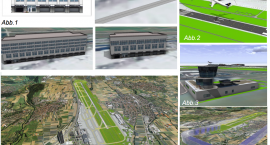3D aerodromes—a VFR-pilot assistance technology for small aircraft

Safe landing in adverse conditions is not only important for big airlines. Partners from Greece, Germany and Italy now developed the technology for a three-dimensional (3D) air navigation database and product for the general aviation sector - that is small and medium sized aircraft used for private use and short-middle range trips.
Pilots of small planes often only have basic compulsory instruments and some added-value navigational aids giving them information on, for example, the aircraft's altitude, speed or location via the GPS display - they still have to rely a lot on eyesight, and to follow visual flight rules (VFR) even in bad weather conditions such as fog.
But that will change thanks to a new product line developed in the framework of the Eurostars project '3D Aerodromes'. The partners developed workflows to produce 2,000 3D airport maps in digital format using available data sources, of which 500+ airports at high resolution and another 400 at a resolution approaching virtual reality. The 3D navigator uses these maps combined with software and hardware developed during the project to safely assist and navigate the pilot during landing and take-off.
"The unique selling proposition of the technology is that it can be used both as a set of navigation instruments and as a safety device that considerably improves pilot visibility in adverse weather conditions," said Prof. Marc Bonazountas, the pilot, engineer and scientist who managed the project on behalf of Epsilon International SA. "Pilots can use the technology to assist take off and landing procedures without having ground-based instrument landing aids."
The Greek company Epsilon International SA, whose business focuses on developing navigational databases, worked with Epsilon Italia and three German companies (ESRI Deutschland, PSU GmbH, Kep 3 AG) and the Italian subsidiary of Wuerth Phoenix GmbH to test and develop the software and prototype hardware. All partners were supported by national funding bodies in their respective country (see info-box). Together they created a spin-off company called avionTek (www.aviontek.com), which was awarded the ESA BIC European Aviation Award in Toulouse, France, in 2012.
A licence agreement for the 3D Pilot's 2D version, including the use of software and databases, has been signed with Germany-based Becker Avionics GmbH. The AirScout 2D navigator made by Becker Avionics is now available for sale throughout Europe.
The potential market for 2D and 3D AirScout navigators is sizeable as there are estimated to be more than 50,000 general aviation aircraft in Europe and more than 45,000 airports world-wide. Other potential customers for the AirScout 3D or related products based on the 3D databases include aircraft and avionics manufacturers, flight schools and training centres, the flight simulator industry, university research and development centres, airports and manufacturers and operators of fixed wing aircraft, helicopters and gyrocopters.
With around 14,000 small airports, the US is a particularly big market for small aircraft. AvionTek GmbH and Becker Avionics GmbH are optimistic to sell their certified multifunction cockpit display (MFD) together with the Aviontek database.
The 3D version of the product, AirScout 3D, which is being tested and prototyped, features a small MFD in the cockpit of the aircraft enabling the pilot to fly using the software. "A corridor is visible on the screen. If the pilot remains in-between the red lines in that virtual tunnel then he/she will safely land on the runway," explains Johannes Gnädinger, CEO, landscape architect, urban planner and GIS expert at PSU GmbH.
"It is an inexpensive solution for VFR pilots approaching the runway, especially in bad weather conditions like in rain or mist, or during the night. We also tested it successfully for navigating the skies in mountainous areas or around islands in the Mediterranean," said Prof. Jörg Schaller, CEO of PSU GmbH Germany.
Provided by Eurostars



















